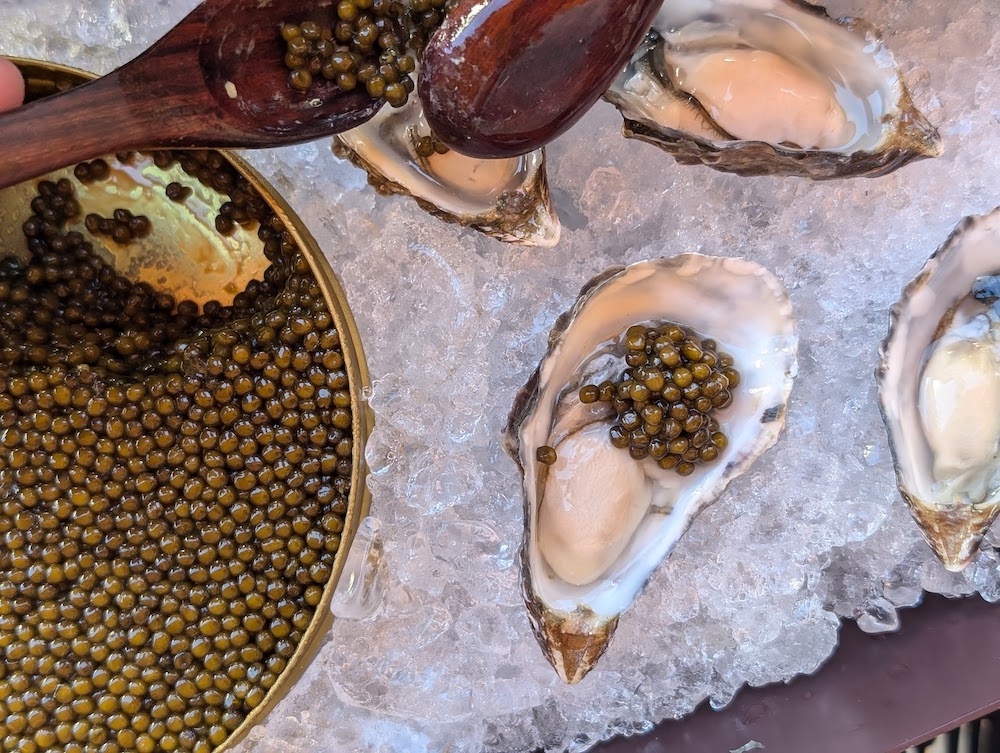
October 8, 2024 – An apparent contradiction accompanied Aubergine’s 20th birthday party last week.
As the most acclaimed restaurant between San Francisco and Santa Monica celebrated a major milestone—and the Monterey Bay region’s first two-Michelin star recognition—it did so without a huge party at Sunset Center or Devendorf Park but with around 20 people, on its courtyard patio.
Lean a little closer, though, and the seeming contradiction gets at the core thing that makes Aubergine great: The huge accomplishments only happen through small-scale interactions, between guest and restaurateur, sommelier and staffer, exec chef and ingredient.
Small batch at its best.
The majority of the modest crowd were longtime customers, the type Aubergine’s guest researcher—who studies what online information is available about people who make reservations to customize service and flag possible inspectors—has the dossier on.
Operations ace and Aubergine partner Janet Elarmo later notes one couple present for the party had dined there 365 times (and will be there tonight for #366, a special “One Coastline, Two Cultures” collaboration with the chefs from Fauna, one of Latin America’s top-ranked restaurants).
“From their names, we know [guest] dietary restrictions and preferences, and after more than a decade, they’re treated as V-VIPs,” she says. “Frankly, all of us know and recognize them too.”
Kelley Swette was another one of the guests at the party. The accomplished food entrepreneur who helped launch Sweet Earth Food Brands flew in for the occasion.
She described Cogley-led cooking classes and field trips to Japan with fellow early adopters, and her own appetite for world class places the planet over, which qualified her for what she said next: “I think they’re under-starred.”
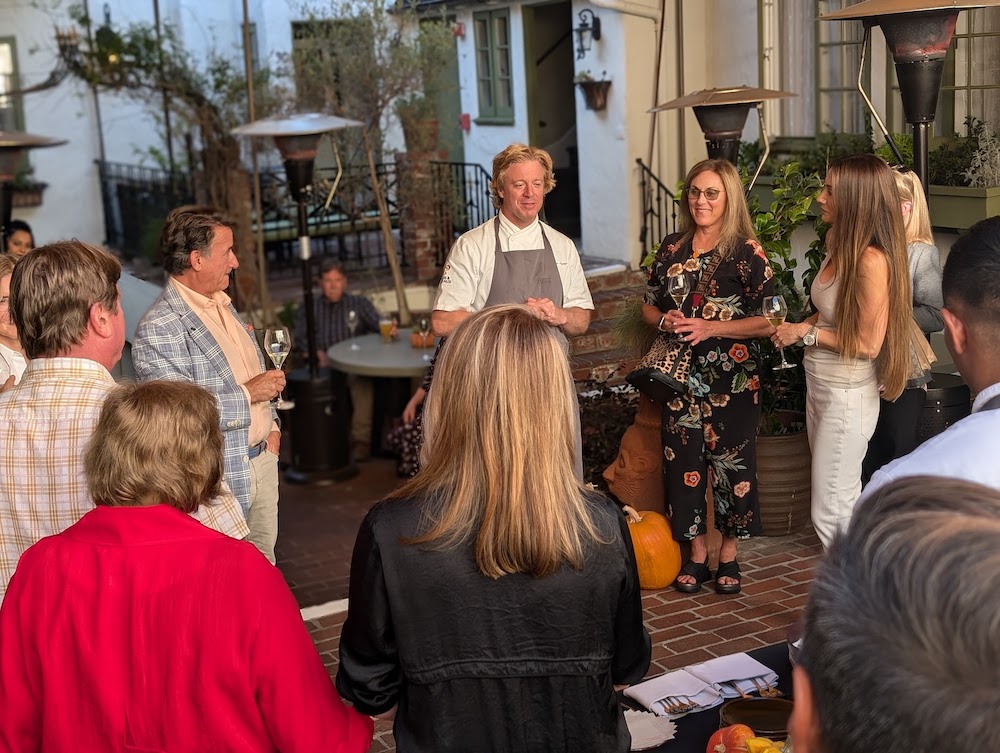
At the party another fun contradiction surfaced: the luxury of simplicity.
Two ingredients starred at a grazing table: chilled caviar and fresh-shucked oysters.
Two choices prevailed at the bar with Michelin-celebrated sommelier John Haffey: luxuriously reductive Willamette Valley Chardonnay and the 162nd version of Krug’s annual Grande Cuvée Brut, one of a handful of 3-liter Jeroboams in circulation from 1990.
OK, maybe the Champagne isn’t so simple. Haffey put it into context, nodding to both the 100 different Champagnes that go into the cuvée blend, and the cooks and staffers who show up midday when service doesn’t start until 6pm and ends closer to midnight.
“The wine is a real collaborative effort,” he said, “much like Aubergine.”
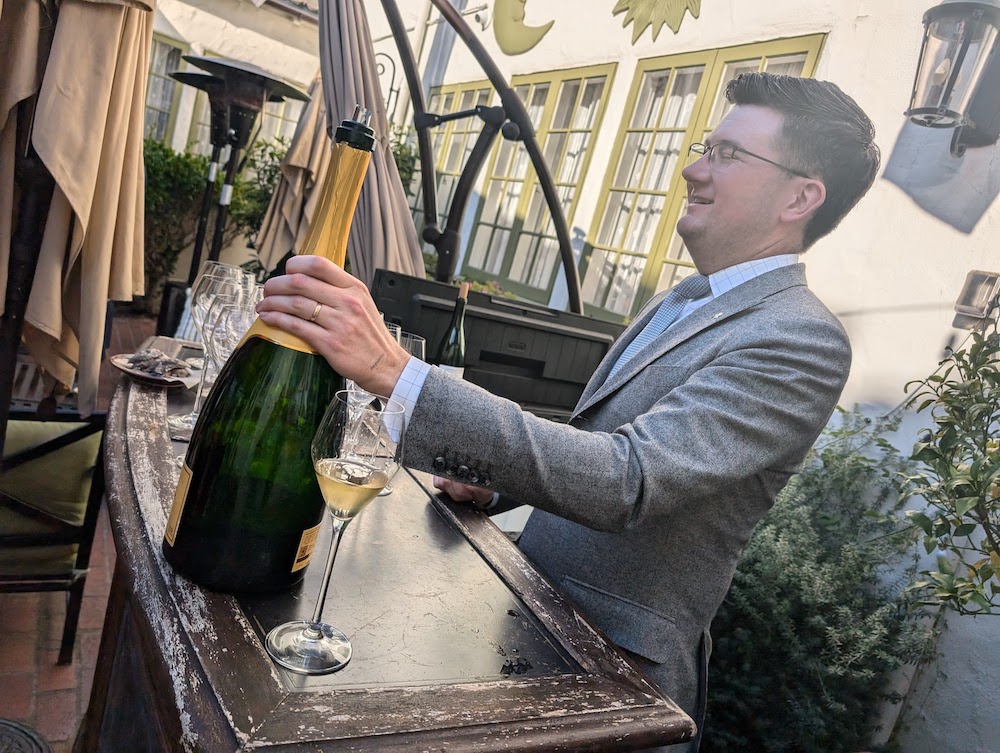
About an hour in, L’Auberge Carmel Relais & Châteaux/Aubergine creator David Fink welcomed the group, thanked the guitarist he’s known since they both worked at Highlands Inn, and shared a little history of the property, which was once a complex of artist bungalows called Sundial Court, and Carmel-by-the-Sea’s first apartment building.
“Tonight’s a celebration of all of you,” he said, “and our team here.”
Executive chef Justin Cogley followed with a brief look back of his own.
“The first day I got here there were only a few people in the kitchen and no one could find the guy who made the eggs,” he said. “Now we have so many people we can’t fit.
“I must say, it’s been quite an adventure.”
That inspired my own gaze back, at some additional moments in Aubergine history that enjoy their own contradictions—or at least intriguing ironies.
There is no good or bad. • Monterey • September 2010
I ran into Fink at Del Monte Center’s Lalla Lounge, and he told me Aubergine’s original exec chef Christophe Grosjean was leaving for his native France. “He doesn’t want to raise his kids in this country,” says Fink, a Francophile whose hotel-restaurant Maison 1896 is about a year old. “Can you blame him?” That opened the door for Cogley to lead the kitchen after time working with celebrated Charlie Trotter of Chicago—and promptly start racking up recognition from Le Chef as one of 100 best chefs on the planet, alongside Thomas Keller, Daniel Humm, Joan Roca and a boatload of famous European chefs like Paul Bocuse, Pierre Gagnaire and Cogley’s personal hero Yannick Alleno.
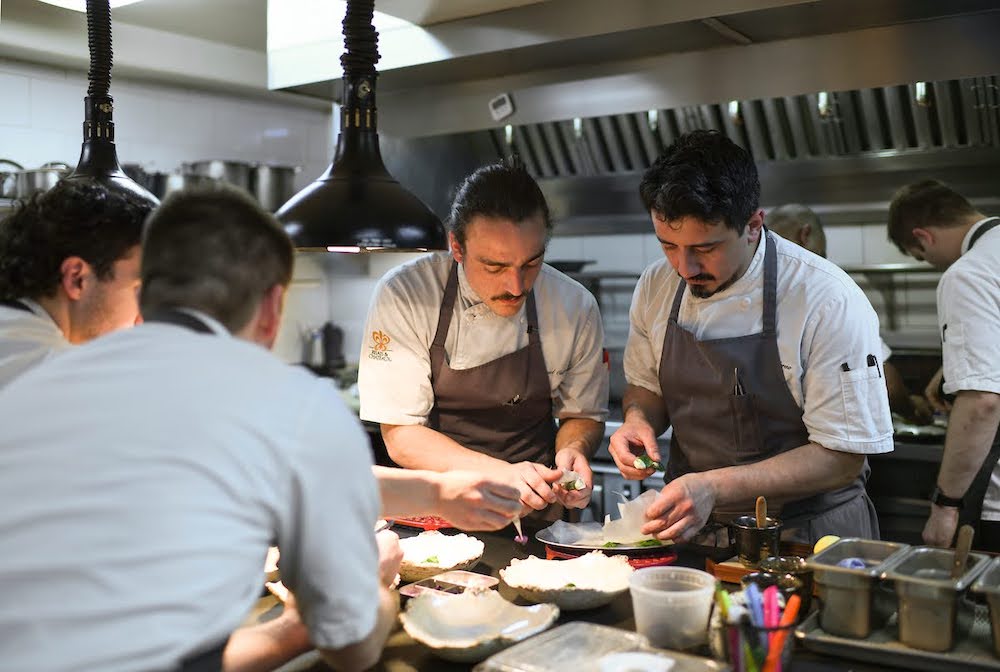
Some can criticize adoration they seek. • Seaside • February 2013
Full disclosure: I’ve been a homer for Aubergine since it started around the same time as my food reporting career. Early on I sat at my desk at Monterey County Weekly, in the working class city where Elarmo grew up and I now live, and ripped Michelin for its arbitrary rules on which restaurants get consideration. “You know how you like to say, as you do on your website, that your ‘obsession with quality and reliability make the Michelin Guide the best source for recommendations’?” I wrote. “Not buying that. Not when your guide’s blind spots are as big as mama blue whale in her third trimester.”
A little cash can help with a priceless endorsement. • France • September 2019
Pre-pandemic, EMB dug into how Michelin partnered with Visit California and contributing tourist boards to lure inspectors here with a six-figure incentive—which led to Aubergine’s first star (“The Michelin Effect: The French rating system’s new California guide is controversial, but at last the Monterey Peninsula has a seat at the table”). “We’ve been doing good food with great chefs for a long time and it doesn’t get any better than Justin,” Fink told me for the purposes of the piece. “But for us, it’s all about our team—the kitchen and front of the house.”
The last place you want to be might turn into one of the best nights of your life. • Half Moon Bay • August 2024
The closest thing to the energy at this year’s California Michelin awards ceremony that I’ve felt is a Golden State Warriors playoff game. At the awards, the tension was more palpable, outright thick. Which is part of the reason Cogley was lingering by the door. He had experienced heartfelt colleagues telling him, “We’re rooting for you,” “Maybe next year,” and wasn’t emotionally prepared to do it again. Instead he ended up on stage, teary-eyed and thankful, anchoring the most moving moment of the night when asked what he would tell his childhood self.
Success can fuel the threat of failure. • Carmel • September 2024
As part of EMB’s current print cover story on fattening up starving sea urchins for uni dishes at places like Aubergine—basically taking zombie echinoderms away from destroying kelp and turning them into a luxury item for chefs like Cogley—he smiled and sighed. “Diners come with greater and greater expectations to have something new and exciting—amazing product isn’t enough, there has to be the wow factor,” he said. “Guests who seek out restaurants like ours look for stories like this.” The morning after the two-star recognition, maybe 12 hours after the roar of relief and validation at Ritz Half Moon Bay, reservations, per Cogley, jumped 600 percent.
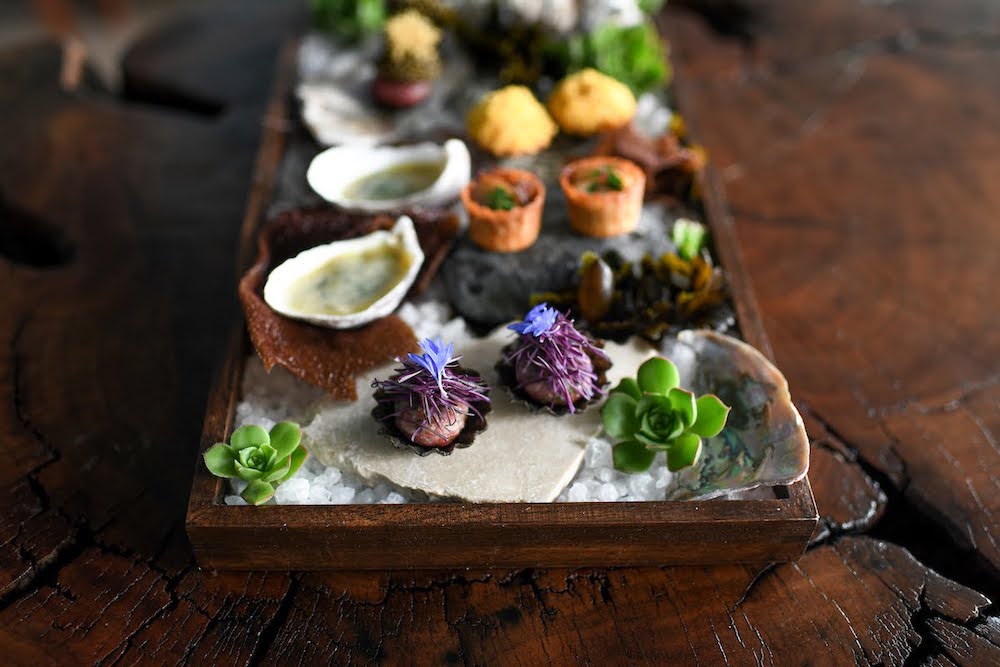
As I was sifting through the seeming contradictions and juxtapositions that make Aubergine the revelation it is—the elegance and the grind, the sacrifice and the joy, the luxury and humility—it hit me.
The analogy of the swan gliding gracefully on the surface, its webbed feet working furiously out of sight, is right there. The more precise comparison would be to a championship figure skater, who toils for hours on technique, conditioning and expression, then waits, breathless, to receive career-changing scores.
The couple who’s getting closer to 400 reservations at Aubergine knows that feels particularly appropriate because Cogley’s first award-winning career was…figure skating.
One final note: The 20 Years + 2 Stars party ended quietly before 6pm.
The Aubergine team had to jump on dinner service.
About the author
Mark C. Anderson, Edible Monterey Bay's managing editor, appears on "Friday Found Treasures" via KRML 94.7 every week, a little after 12pm noon. Reach him via mark@ediblemontereybay.com.
- Mark C. Andersonhttps://www.ediblemontereybay.com/author/markcanderson/
- Mark C. Andersonhttps://www.ediblemontereybay.com/author/markcanderson/
- Mark C. Andersonhttps://www.ediblemontereybay.com/author/markcanderson/
- Mark C. Andersonhttps://www.ediblemontereybay.com/author/markcanderson/



